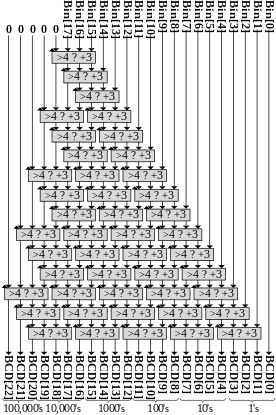Algorithm
The algorithm operates as follows:
Suppose the original number to be converted is stored in a register that is n bits wide. Reserve a scratch space wide enough to hold both the original number and its BCD representation; n + 4×ceil(n/3) bits will be enough. It takes a maximum of 4 bits in binary to store each decimal digit.
Then partition the scratch space into BCD digits (on the left) and the original register (on the right). For example, if the original number to be converted is eight bits wide, the scratch space would be partitioned as follows:
Hundreds Tens Ones Original 0010 0100 0011 11110011
The diagram above shows the binary representation of 24310 in the original register, and the BCD representation of 243 on the left.
The scratch space is initialized to all zeros, and then the value to be converted is copied into the "original register" space on the right.
0000 0000 0000 11110011
The algorithm then iterates n times. On each iteration, any BCD digit which is at least 5 (0101 in binary) is incremented by 3 (0011); then the entire scratch space is left-shifted one bit. The increment ensures that a value of 5, incremented and left-shifted, becomes 16 (10000), thus correctly "carrying" into the next BCD digit.
Essentially, the algorithm operates by doubling the BCD value on the left each iteration and adding either one or zero according to the original bit pattern. Shifting left accomplishes both tasks simultaneously. If any digit is five or above, three is added to ensure the value "carries" in base 10.
The double-dabble algorithm, performed on the value 24310, looks like this:
0000 0000 0000 11110011 Initialization 0000 0000 0001 11100110 Shift 0000 0000 0011 11001100 Shift 0000 0000 0111 10011000 Shift 0000 0000 1010 10011000 Add 3 to ONES, since it was 7 0000 0001 0101 00110000 Shift 0000 0001 1000 00110000 Add 3 to ONES, since it was 5 0000 0011 0000 01100000 Shift 0000 0110 0000 11000000 Shift 0000 1001 0000 11000000 Add 3 to TENS, since it was 6 0001 0010 0001 10000000 Shift 0010 0100 0011 00000000 Shift 2 4 3 BCD
Now eight shifts have been performed, so the algorithm terminates. The BCD digits to the left of the "original register" space display the BCD encoding of the original value 243.
Another example for the double dabble algorithm – value 6524410.
104 103 102 101 100 Original binary 0000 0000 0000 0000 0000 1111111011011100 Initialization 0000 0000 0000 0000 0001 1111110110111000 Shift left (1st) 0000 0000 0000 0000 0011 1111101101110000 Shift left (2nd) 0000 0000 0000 0000 0111 1111011011100000 Shift left (3rd) 0000 0000 0000 0000 1010 1111011011100000 Add 3 to 100, since it was 7 0000 0000 0000 0001 0101 1110110111000000 Shift left (4th) 0000 0000 0000 0001 1000 1110110111000000 Add 3 to 100, since it was 5 0000 0000 0000 0011 0001 1101101110000000 Shift left (5th) 0000 0000 0000 0110 0011 1011011100000000 Shift left (6th) 0000 0000 0000 1001 0011 1011011100000000 Add 3 to 101, since it was 6 0000 0000 0001 0010 0111 0110111000000000 Shift left (7th) 0000 0000 0001 0010 1010 0110111000000000 Add 3 to 100, since it was 7 0000 0000 0010 0101 0100 1101110000000000 Shift left (8th) 0000 0000 0010 1000 0100 1101110000000000 Add 3 to 101, since it was 5 0000 0000 0101 0000 1001 1011100000000000 Shift left (9th) 0000 0000 1000 0000 1001 1011100000000000 Add 3 to 102, since it was 5 0000 0000 1000 0000 1100 1011100000000000 Add 3 to 100, since it was 9 0000 0001 0000 0001 1001 0111000000000000 Shift left (10th) 0000 0001 0000 0001 1100 0111000000000000 Add 3 to 100, since it was 9 0000 0010 0000 0011 1000 1110000000000000 Shift left (11th) 0000 0010 0000 0011 1011 1110000000000000 Add 3 to 100, since it was 8 0000 0100 0000 0111 0111 1100000000000000 Shift left (12th) 0000 0100 0000 10100111 1100000000000000 Add 3 to 101, since it was 7 0000 0100 0000 1010 1010 1100000000000000 Add 3 to 100, since it was 7 0000 1000 0001 0101 0101 1000000000000000 Shift left (13th) 0000 1011 0001 0101 0101 1000000000000000 Add 3 to 103, since it was 8 0000 1011 0001 10000101 1000000000000000 Add 3 to 101, since it was 5 0000 1011 0001 1000 1000 1000000000000000 Add 3 to 100, since it was 5 0001 0110 0011 0001 0001 0000000000000000 Shift left (14th) 0001 1001 0011 0001 0001 0000000000000000 Add 3 to 103, since it was 6 0011 0010 0110 0010 0010 0000000000000000 Shift left (15th) 0011 0010 1001 0010 0010 0000000000000000 Add 3 to 102, since it was 6 0110 0101 0010 0100 0100 0000000000000000 Shift left (16th) 6 5 2 4 4 BCD
Sixteen shifts have been performed, so the algorithm terminates. The decimal value of the BCD digits is: 6*104 + 5*103 + 2*102 + 4*101 + 4*100 = 65244.
Historical
In the 1960s, the term double dabble was also used for a different mental algorithm, used by programmers to convert a binary number to decimal. It is performed by reading the binary number from left to right, doubling if the next bit is zero, and doubling and adding one if the next bit is one. [5] In the example above, 11110011, the thought process would be: "one, three, seven, fifteen, thirty, sixty, one hundred twenty-one, two hundred forty-three", the same result as that obtained above.
